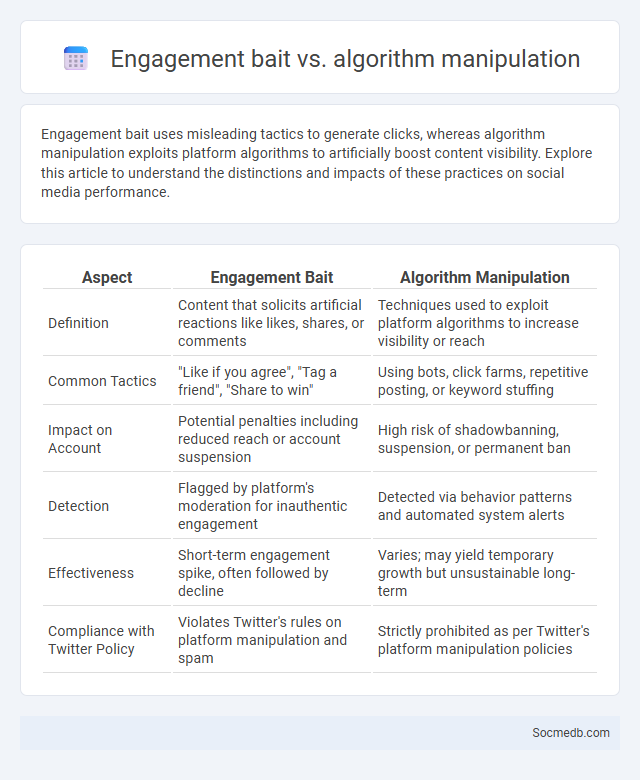
Photo illustration: Engagement bait vs Algorithm manipulation
Engagement bait uses misleading tactics to generate clicks, whereas algorithm manipulation exploits platform algorithms to artificially boost content visibility. Explore this article to understand the distinctions and impacts of these practices on social media performance.
Table of Comparison
| Aspect | Engagement Bait | Algorithm Manipulation |
|---|---|---|
| Definition | Content that solicits artificial reactions like likes, shares, or comments | Techniques used to exploit platform algorithms to increase visibility or reach |
| Common Tactics | "Like if you agree", "Tag a friend", "Share to win" | Using bots, click farms, repetitive posting, or keyword stuffing |
| Impact on Account | Potential penalties including reduced reach or account suspension | High risk of shadowbanning, suspension, or permanent ban |
| Detection | Flagged by platform's moderation for inauthentic engagement | Detected via behavior patterns and automated system alerts |
| Effectiveness | Short-term engagement spike, often followed by decline | Varies; may yield temporary growth but unsustainable long-term |
| Compliance with Twitter Policy | Violates Twitter's rules on platform manipulation and spam | Strictly prohibited as per Twitter's platform manipulation policies |
Understanding Engagement Bait: Definition and Examples
Engagement bait refers to social media posts designed to manipulate users into interacting through tactics like asking for likes, shares, or comments to boost visibility artificially. Common examples include posts instructing users to "Like if you agree," "Tag a friend who needs to see this," or "Share to win a prize," which exploit algorithms by prioritizing engagement over content quality. Platforms like Facebook actively penalize engagement bait to maintain authentic user interactions and reduce spammy content in news feeds.
What Is Algorithm Manipulation? An Overview
Algorithm manipulation refers to the strategic alteration or exploitation of social media platform algorithms to influence content visibility and user engagement artificially. This practice often involves tactics such as keyword stuffing, engagement pods, or coordinated posting patterns to boost rankings, reach, or virality disproportionately. Understanding algorithm manipulation is essential for maintaining authentic digital marketing strategies and ensuring platform integrity.
Key Differences: Engagement Bait vs Algorithm Manipulation
Engagement bait uses explicit calls to action like "comment if" or "share this" to artificially boost interactions, often leading to lower content quality and platform penalties. Algorithm manipulation involves tactics such as click farms or automated bots to deceive platform algorithms into promoting content beyond its organic reach. Both strategies undermine genuine user engagement but differ in execution and detection methods used by social media platforms like Facebook and Instagram.
The Psychology Behind Engagement Bait Tactics
Engagement bait tactics exploit psychological triggers such as social reciprocity, fear of missing out (FOMO), and social validation to manipulate users into interacting with content. By prompting users to like, comment, or share through emotionally charged or curiosity-inducing calls-to-action, these strategies increase visibility and reach on platforms governed by algorithmic prioritization. Understanding these mechanisms reveals how engagement bait influences user behavior and content virality in social media ecosystems.
Common Forms of Algorithm Manipulation on Social Media
Common forms of algorithm manipulation on social media include coordinated inauthentic behavior, such as using fake accounts to amplify certain content, and engagement pods, where groups artificially boost likes and shares to increase visibility. Another prevalent tactic is clickbaiting with misleading headlines that exploit algorithm preferences for high engagement metrics. These practices distort organic reach and mislead users by prioritizing manipulated content over authentic interactions.
How Social Networks Detect Engagement Bait
Social networks detect engagement bait by using machine learning algorithms that identify patterns of repetitive calls to action, such as "like this," "share now," or "comment below." These platforms analyze user interactions and flag posts exhibiting unnatural spikes in engagement metrics, including clicks, shares, and comments generated through manipulative tactics. Facebook's and Instagram's proprietary systems continuously update detection models to reduce the visibility of engagement bait, prioritizing authentic content and improving user experience.
Impacts of Engagement Bait and Algorithm Manipulation on User Experience
Engagement bait tactics exploit social media algorithms to artificially boost interaction metrics, leading to lower content quality and increased user frustration. Algorithm manipulation skews content visibility, reducing the diversity of posts You see and fostering echo chambers that limit exposure to varied perspectives. These practices collectively degrade Your user experience by prioritizing quantity of interactions over meaningful, authentic engagement.
Platform Policies: Combatting Engagement Bait and Manipulation
Social media platforms enforce strict policies to combat engagement bait and manipulation, aiming to preserve authentic user interactions and maintain community trust. These policies restrict misleading tactics like clickbait, fake reactions, or coordinated inauthentic behavior that artificially inflate engagement metrics. Understanding and adhering to these rules helps you create genuine content that aligns with platform standards and fosters meaningful connections.
Ethical Considerations for Marketers and Content Creators
Social media marketers and content creators must prioritize transparency, honesty, and respect for user privacy to build trust and maintain credibility with their audience. Ensuring your campaigns avoid misleading information and data misuse aligns with ethical standards, fostering long-term engagement and brand loyalty. Adhering to these principles not only protects your reputation but also contributes to a healthier digital environment.
Best Practices: Sustainable Engagement Without Algorithm Abuse
Sustainable engagement on social media prioritizes authentic interactions by creating valuable, relevant content tailored to target audiences, fostering genuine community connections that encourage natural growth. Emphasizing transparency, consistent posting schedules, and respectful communication avoids algorithm manipulation tactics like spam, clickbait, or excessive hashtag use. Leveraging platform-specific features ethically enhances visibility while maintaining trust and long-term user retention.
 socmedb.com
socmedb.com